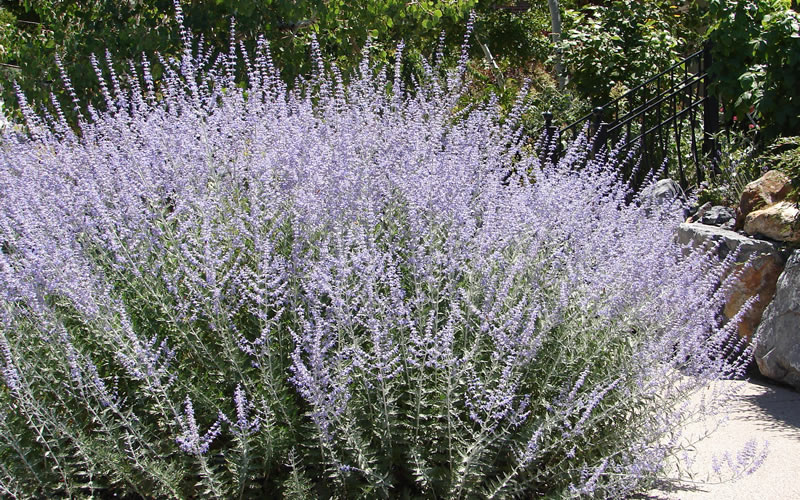Russian sage (Perovskia atriplicifolia) is an especially hardy plant. It is able to survive a wide range of adverse conditions – heat and cold, salt and poor soil, as well as drought – while painting the landscape with cheerful blue blooms and delicate silvery foliage.
Interestingly, Russian sage is neither native to the country of Russia, nor is it a true sage, of the genus Salvia. The name may be derived from the plant’s use in a vodka based cocktail. Russian sage has been cultivated since at least 1904.

Quick Facts about Russian Sages
Height: 3 feet
Lifespan: Perennial
Flowers: Small blue violet, tubular flowers in spires
Seeds: Dark brown and nutlike
Leaves: Deciduous, elongate and grey-green, arrange in opposite pairs
Regions: Zones 3 through 9, encompassing all but the southernmost reaches of California, Texas, and Florida
Genus: Perovskia
Species: Perovskia atriplicifolia
Appearance
Russian sage resembles lavender, only it is much larger. This deciduous shrub-like plant has aromatic, grey-green stems and leaves. The scent of the crushed leaves resembles a cross between sage and lavender. The growth of the current season produces spires of blue flowers from late summer to early autumn. The plant reaches a height of three feet, with a four foot spread. From a distance, the blooming plant appears as a blue haze or cloud.
Environment
Russian sage is native to the hilly country of Asia and eastern Europe, including China and the Middle East. It has been found growing as high as 10,000 feet in the Himalayan mountains. It can thrive in a various soil types, including soils low in nutrients, and diverse climatic conditions, making it ideal for gardens around the world.
Russian sage is recommended for USDA Hardiness Zones 3 through 9. The plant can survive cold temperatures as well as hot. Only the southernmost regions of California, Texas, and Florida do not provide an ideal environment.
Varieties
Cultivars of Russian sage have been developed. These differ mainly in height of the plant and in leaf shape. The following are among the most common:
“Blue Spire” is a very popular cultivar, and its beauty and versatility have merited the plant a number of awards. It grows three feet in height and has dark blue flowers.
“Filigran” is a tall variety, reaching four feet. It has lacy leaves.
“Little Spire” reaches only two feet in height.
“Longin” is an upright variety.
“Mystery of Knightshayes” blooms later than other varieties.
Other cultivars of Russian sage include “Blue Haze,” “Lace,” “Blue Mist,” “Hybrida” or “Superba,” “Rocketman,” “Lisslit,” and “WALPPB.”
Care
Plant in full sun. Shady conditions will result in leggy plants that bend if not given support. Plant young plants in soil mixed with peat and sand. Plants also do well in containers.
Russian sage is tolerant of dry, chalky soil as well as heavy clay soil, making it ideal for drought prone areas. This is due to a deep tap root. Over watering or fertilizing may result in a decline in plant health. Prune to 24 inches or less in early spring. This allows for new growth and promotes flowering.
During extremely cold weather, Russian sage may require mulching or other protection. It can typically withstand temperatures as low as negative 23 degrees Fahrenheit without protection.
Benefits
Because it can survive in areas with poor soil quality, Russian sage can be grown in bare, drought prone areas where other plants fail to thrive. It is not palatable to grazing animals, and is therefore considered deer and rabbit resistant.
The flowers of Russian sage are edible; they make a colorful addition to garden salads. The flowers can also be crushed and used to make a natural blue dye. The blooms of the plant are also attractive to birds, bees, and butterflies.
Russian sage is also a plant used in phytoremediation, environmental cleanup that utilizes a plant’s natural ability to remove pollutants from the soil. It may have the ability to remove heavy metals and other toxins from the soil.
